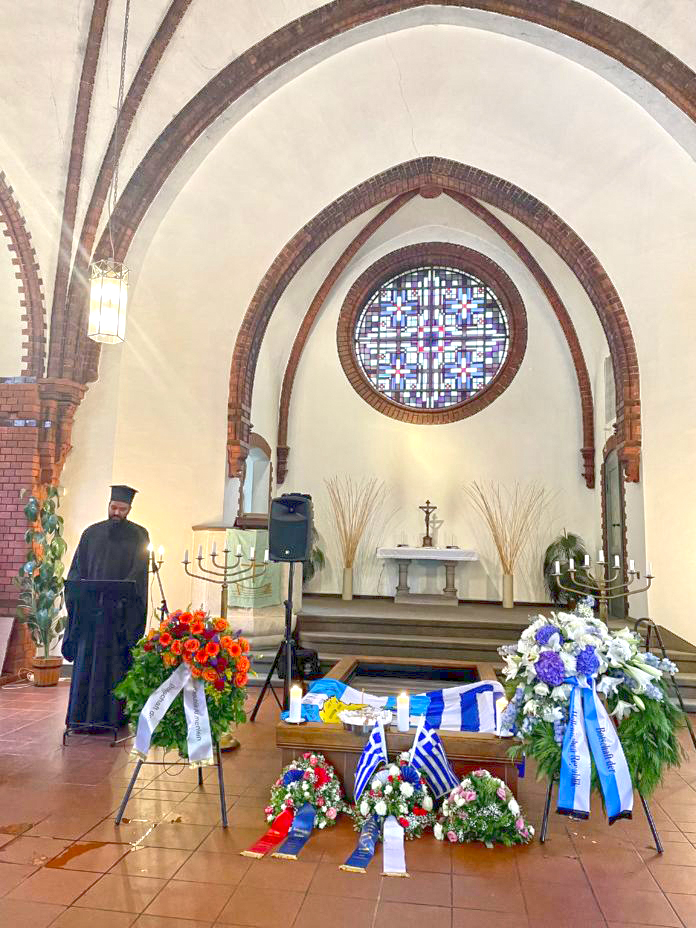
Father Theofilos Sofitsis
Berlin Program Marks Centennial of Burning of Smyrna
by Muriel Mirak-Weissbach
BERLIN, SEPTEMBER 21, 2022 — “The Smyrna horror is beyond the conception of the imagination and the power of words.” This is how an American physician, Dr. Esther Clayson Pohl Lovejoy (1869-1967), characterized the events she witnessed in the city of Smyrna in September 1922.
In the German capital, one hundred years later — almost to the day — diplomats, political figures, representatives of the Greek and Armenian communities, civil society and clergy, as well as citizens from Berlin and beyond gathered to commemorate the victims of The Great Fire of Smyrna.
On September 10, Prof. Tessa Hofmann, spokeswoman of the Board of the Promotional Society for the Ecumenical Monuments for Genocide Victims of the Ottoman Empire (FÖGG), gave a guided tour of the altars of remembrance honoring the Greek, Syrian Orthodox and Armenian victims of the Ottoman genocide, located in the Luisenkirchhof cemetery in Berlin-Charlottenburg. The following day, in the chapel of the cemetery, she opened the program with a review of the historical events.
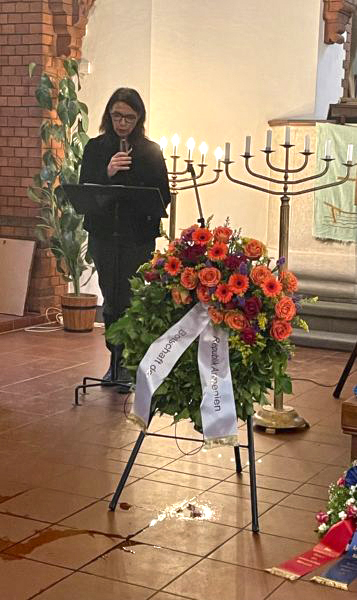
Bea Ehlers-Kerbekian reads eye-witness accounts
Capture, Plunder, Massacre and Arson
At the time of its capture on September 8, 1922, Smyrna was a city without defenses. “Hours prior to the entry of Kemalist armed forces, the Greek armed forces, who, tasked in May 1919 by the Allies to take over the defense of the Christian population in the Smyrna district, had left by sea,” Hofmann said.
A Christian majority of the city of a half million inhabitants, included 150,000 Greek Orthodox Ottoman citizens, 25,000 Armenians, several thousand Italians, French, British and about 100 Americans, according to contemporary diplomatic sources.
Days following the September 9 capture of the city, Kemalist commander Nureddin Pasha (known as the “butcher of Smyrna”) took advantage of shifting winds to order the Armenian quarter Hajnoz be set afire and the flames soon engulfed the neighboring Greek neighborhood. “At least 150,000 Greeks and Armenians perished in the capture of the city,” burned or crushed by collapsing homes; massacred or drowned in the vain attempt to “swim to the 27 foreign warships and merchant ships anchored in the Gulf of Smyrna.” This meant, Hofmann said, that the “tragedy unfolded before the eyes of a huge international public: missionaries and teachers, diplomats and tradesmen, as well as the crews of the ships in the Gulf.” One of them, an Anglican pastor from New Zealand, Charles Dobson, would choose the Biblical Greek term “Holocaust” — meaning “whole burnt-offering or wholesale sacrifice” — to depict the catastrophe. The term, Hofmann explained, had been in use in American and European media since 1895 in reference to Ottoman Christians burned alive, and in 1958 Nobel Prize winner Elie Wiesel adopted it for the Shoah, Nazi Germany’s elimination of European Jews.
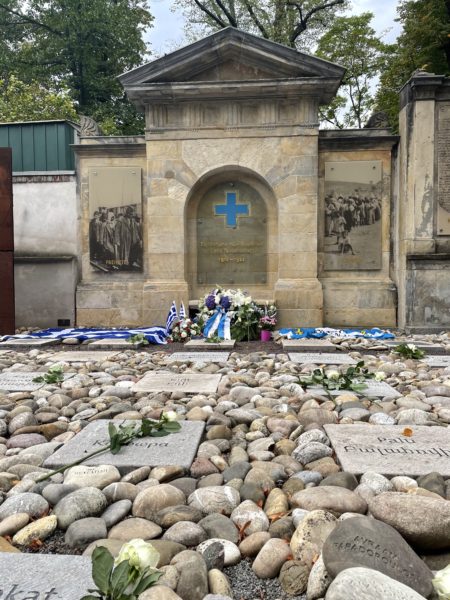
Wreaths at the Altars of remembrance
In addition to the devastation wrought by the Great Fire, about 300,000 Greek men became forced laborers, under Nureddin Pasha’s orders, while remaining Christians were given two weeks to leave the country. Hofmann drew a striking comparison to the situation surrounding the Ukraine war: “The former allies of Greece wanted to save the Christian people of the Ottoman Empire, without becoming involved themselves in the conflict or damaging their economic interests,” for example, France’s trade relations with Kemalist Turkey. Another aspect recalled by the Ukraine war relates to the evacuation; unlike today, in 1922 the quarter million people, mainly women and children, who were forced to flee had no logistical backup, transportation, personnel or experience. Rather, Hofmann suggested, what the Smyrna evacuation anticipated in recent experience is the withdrawal from Afghanistan; there too, it was local personnel, teachers, translators and domestic staff, who were left behind, “not-naturalized Greeks and Armenians sent back to the ports.”
The Great Fire of Smyrna, Hofmann concluded, marked not only an unprecedented humanitarian disaster, but also the “bloody conclusion” of the decade-long genocide, initiated by the Young Turks and carried forward by Kemal Ataturk after 1919. From the deportations and massacres of Greeks in Aydın or Smyrna province in 1914, to the Great Fire and massacre of 40,000 Christians in Manissa in 1922, where many survivors of the previous attacks died, to the forced laborers in 1923 — it was one process. A process of elimination of Ottoman Christians, Hofmann concluded, that Taner Akçam “rightly depicted as the founding crimes of the Republic of Turkey. Out of the multireligious Ottoman Empire Turkey for the Turks was born.”
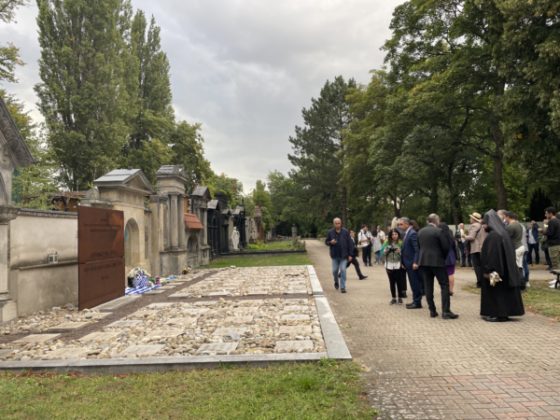
The commemoration at the cemetery
Lessons of Smyrna
Diplomats from the embassies of Greece and the Republic of Armenia, along with representatives of the Armenian community and Evangelical Church delivered brief messages of greetings. Consul Andreas Spyropoulos, 2nd Secretary of the Greek Embassy, was followed by Viktor Yengibaryan, Armenian ambassador, who presented that country’s efforts to advance the international agenda on preventing genocide.
Jonathan Spangenberg, chairman of the Central Council of Armenians in Germany (ZAD), sketched the events from August 30, when the Kemalists broke through Greek front lines, forcing their retreat, and the flow of 150,000 refugees to Smyrna, to capture of the city and the massacres, plundering and deportations that preceded the Great Fire. In light of Europe’s experience with Nazi Germany and the Holocaust, and the consensus in remembrance culture, Spangenberg stated, it is a central concern of the ZAD to commemorate the genocide against Armenians, Greeks and Aramaeans, not only to keep the memory alive, but to prevent the reemergence of discrimination and persecution. In this regard, he underlined the need for countering denialism, especially in school curricula. In closing he referenced Greek-Turkish tensions in the Aegean as well as the Nagorno-Karabakh crisis, where Azerbaijan’s racially motivated policy has forced Armenians to flee.
Pastor Marion Gardei, Representative for Memory Culture, Evangelical Church Berlin-Bandenburg-Silesian Upper Lusatia (EKBO), spoke next. In her remarks, she highlighted the “cosmopolitan flair” of the prosperous trading and port city Smyrna since the 17th century, a flair that earned it the name “Little Paris of the Orient.” The peaceful cohabitation of Christians, Jews and Muslims there rivalled that of many European cities. Following the capture and destruction of Smyrna, the new borders sealed in the 1923 Lausanne Treaty between Greece and Turkey led to the mass population transfer, and the victory of the nationalist ideology, and further wars. With critical words for Turkey’s denialist policy, Gardei stressed the importance of memory culture as grounded in the biblical depiction of God’s care for His people.
Father Theofilos Sofitsis, from the Greek Orthodox Parish Christi Himmelfahrt, Berlin, delivered a substantial address of “The Path to Holiness: The Work of Saint Chrysostomos as Metropolitan of Smyrna through his Correspondence.”
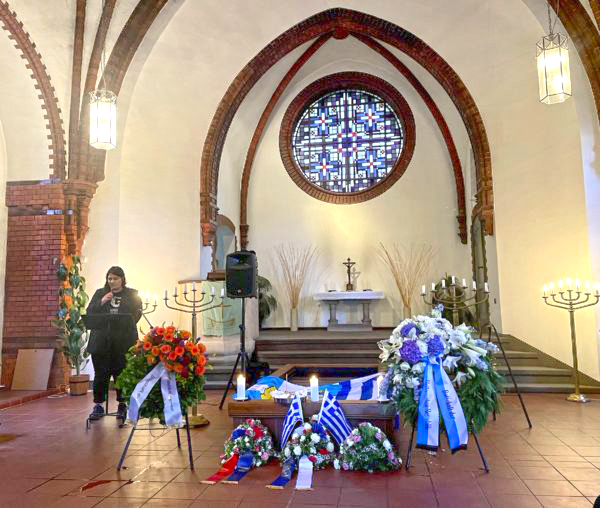
Moderator by Parthena Iordanidou
The Survivors’ Testimony
Nothing can communicate the drama of such historical watershed events better than the words uttered by those who lived through them and found the emotional strength and means to bear testimony. Actress Bea Ehlers-Kerbekian, from Berlin, read selections from Dr. Garabed Hacherian, Pastor Charles Dobson and Esther Clayson Pohlson Lovejoy. Their accounts detail various aspects of the atrocities: the cold-blooded approach of the perpetrators, the brutality of their assaults, the massive destruction of the city, the plight of the civilian population, the suffering.
Hacherian was a doctor who had attended Armenian and American schools, studied medicine in the capital and served in the Ottoman armed forces during the war. In his diary, published by his daughter, Dora Sakayan, he recorded his direct knowledge of Turkish soldiers’ setting the fire. On September 13, he encountered a Turk, who said to him: “‘We have done what we had to do; go back!’ The Turk, who must have played an active role in setting the fire and takes me for a compatriot and accomplice, advised me not to go further and to turn back…. Little by little the flames approached our house. The clatter of burning buildings and the transformation of fuel into clouds of fire confront me with a hellish image that was unknown to me. In Constantinople and other cities I have experienced huge fires, and on the battlefields of the Dardanelles and in Rumania I was witness to the pillaging of entire cities and villages, yet none of the conflagrations had moved me so much up to now. The fire of Smyrna is indescribable and incredible. Our situation is hopeless.”
Bea Ehlers-Kerbekian introduced Dobson, an Anglican pastor who was in Smyrna at the time of the fire, and later testified in a trial which concluded that the fire had been deliberately set. Born in New Zealand, he had served as a military chaplain on the Western front and in Gallipoli, before going to Smyrna in 1922. There he comforted terrified Christians and buried their dead. Evacuated on September 14, and transferred to Malta, he learned that some refused to believe the Turks had deliberately burned the city. His report, published in 1923 as The Smyrna Holocaust, described the atrocities in gruesome detail, bloodied infants, ravaged women, robberies and more.
Ehlers-Kerbekian concluded her readings with selections from the account provided by Esther Clayson Pohl Lovejoy. She was Director of the American Women’s Hospitals Service (AWHS), which she helped establish to bring humanitarian relief to displaced and injured victims of war. In Geneva attending a conference when the Smyrna fire broke out, she was dispatched immediately to the site. She read, in part:
“I was the first American Red Cross woman in France,” she said, “but what I saw there during the Great War seems a love feast beside the horrors of Smyrna. When I arrived at Smyrna there was massed on the quays 250,000 people — wretched, suffering and screaming — with women beaten and with their clothes torn off them, families separated and everybody robbed.
“Knowing their lives depended on escape before Sept. 30, the crowds remained packed along the water front — so massed that there was no room to lie down. The sanitary conditions were unspeakable.
“Three-quarters of the crowd were women and children, and never have I seen so many women carry children. It seemed that every other woman was an expectant mother. The flight and the conditions brought on many premature births, and on the quay with scarcely room to lie down and without aid most of the children were born. In the five days I was there more than 200 such confinements occurred.
“Even more heartrending were the cries of children who had lost their mothers or mothers who had lost their children. They were herded along through the great guarded enclosure, and there was no turning back for lost ones. Mothers in the strength of madness climbed the steel fences fifteen-feet high and in the face of blows from the butts of guns sought the children, who ran about screaming like animals.
“Under the order to remain neutral I saw the launch of an American warship pick up two male refugees who were trying to swim to a merchant ship under the Turkish rifle fire and return them to the hands of the waiting Turk soldiers on the beach for what must have been certain death. And under orders to remain neutral I saw soldiers and officers of all nationalities stand by while Turk soldiers beat with their rifles women trying to reach children who were crying just beyond the fence.”
Esther Lovejoy succeeded in wielding “the power of words” to convey the “horror of Smyrna” and its lessons: “It is a crime for which the whole world is responsible in not having through the civilized ages built up some means to prevent such orders as that of the evacuation of a city and the means with which it was carried out. It is a crime for the world to stand by through a sense of neutrality and permit this outrage against 200,000 women.”
The program was accompanied by musical selections of Greek songs from Asia Minor performed by singer Maritina Asoniti, violinist Penelope Gkika and Shingo Ali Masuda on the Kanoon and Guitar. Father Theofilos Sofitsis offered requiem prayers and wreaths were laid at the Ecumenical Monuments.
(The selections read by Bea Ehlers-Kerbekian were in German, the first in Sakayan, Dora (Hg.): Smyrna 1922: Das Tagebuch des Garabed Hatscherian. Klagenfurt, Wien: Kitab, 2006, S. 79f. I have translated this, Dobson and the song lyrics into English. Dr. Lovejoy’s text in English comes from a press account: “Woman pictures Smyrna horrors: Dr. Esther Lovejoy, an eyewitness, tells of terrible scenes on the Quay; she assails neutrality; declares it a crime for the world to lack the means to prevent such outrages.” The New York Times, October 9, 1922, page 3.)